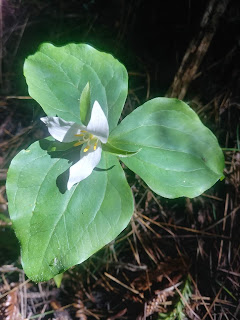The western fairy-slipper lives in shady forests and bogs. Its bright color and sweet smell attracts pollinators—especially newly hatched queen bumblebees who don't realize that it offers no nectar.
Spring is wildflower season. The showiest blooms, called superblooms, happen in sunny grasslands where poppies, lupines and others paint whole hillsides, especially if the rains have been good. These are most dramatic in Central and Southern California where it is drier. In Northern California, there is enough rain that introduced European grasses take over many grasslands, leaving less room for native wildflowers. This spring, I have been appreciating a less dramatic class of wildflowers: those that bloom in deep shade in the forest, such as the western fairy-slipper.
In the superbloom grasslands, the limiting factor is water. In dry years, the blooms are much less dramatic, and the flowers disappear as the spring dries out and heats up on its way to summer. In the shade of forests, the limiting factor for flowers is often light. Only flowering plants that are adapted to photosynthesize in low-light conditions survive, and they tend not to grow in carpets but in small patches where light makes it to the forest floor.
Look carefully in the shady woods and you might see the white petals of a pacific trillium unfurled in the center of three wide leaves, or the giant wakerobin, a trillium with a larger, dark-magenta flower.
The seeds of trilliums are dispersed by ants. Ants take the seeds in order to eat the elaiosomes—little blobs of protein and fat—that grow attached to the seeds. Trilliums grow in wet shady areas, often near streams. Another wildflower found in similar habitat are largeflower fairybells, elegant white bells that hang in small bunches.
The checker lily (or chocolate lily) is a wildflower of the shade that is found in drier forests, such as oak forests in the Napa hills. Looking from above, you might not even notice the flowers, since the outside of the petals are so muted. Inside, they have brighter yellow and brick red.
LINKS:
California Native Plant Society
Salt Point State Park (where I saw the western fairy-slipper and pacific trillium)
Steep Ravine Trail (where I saw the giant wakerobin and largeflower fairybells)





No comments:
Post a Comment